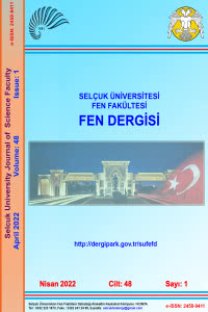Pd/C CATALYSTS SYNTHESIZED BY MICROWAVE ASSISTED POLYOL METHOD FOR FORMIC ACID ELECTRO-OXIDATION
Mikrodalga Destekli Poliol Yöntemiyle Sentezlenen Pd/C Katalizörler için Formik Asit Elektro-Oksidasyonu
___
- Antolini E., 2009, “Palladium in Fuel Cell Catalysis”, Energy & Environmental Science, Vol. 2 (9), pp. 915-931.
- Guo, P., Wei, Z., Ye, W., Qin, W., Wang, Q., Guo, X., Lu, C., Zhao, X.S., 2012, “Preparation and Characterization of Nanostructured Pd with High Electrocatalytic Activity”, Colloids and Surfaces A: Physicochemical and Engineering Aspects, Vol. 395, pp. 75−81.
- Harish S., Baranton S., Coutanceau C., Joseph J., 2012, “Microwave Assisted Polyol Method for The Preparation of Pt/C, Ru/C and PtRu/C Nanoparticles and Its Application in Electrooxidation of Methanol” Journal of Power Sources, Vol. 214, pp. 33-39.
- Husin M.H.M., Nordin M.R., Mohamad I.S., Yong L.K., 2014, “Pt –Cu Bimetallic Nanoparticles Synthesized by Polyol Method Under Different Reduction Conditions”, Journal of Mechanical Engineering and Technology, Vol. 6 (1), pp. 77-86.
- Mazumder V., Lee Y.M., Sun S.H., 2010, “Recent Development of Active Nanoparticle Catalysts for Fuel Cell Reactions”, Advanced Functional Materials, Vol. 20, pp.1224-1231.
- Nethravathi C., Anumol E.A., Rajamathi M., Ravishankar N., 2011, “Highly Dispersed Ultrafine Pt and PtRu Nanoparticles on Graphene: Formation Mechanism and Electrocatalytic Activity”, Nanoscale, Vol. 3, pp. 569–571.
- Sarto, F., Castagna, E., De Francesco, M., Dikonimos, T. M., Giorgi, L., Lecci, S., Sansovini, M., Violante, V., 2014, “Morphology and Electrochemical Properties of Pd-Based Catalysts Deposited by Different Thin-Film Techniques”, International Journal of Hydrogen Energy, Vol. 39, pp. 14701−14711.
- Shao, M.H., Huang, T., Liu, P., Zhang, J., Sasaki, K., Vukmirovic, M.B., Adzic, R.R., 2006, “Palladium Monolayer and Palladium Alloy Electrocatalysts for Oxygen Reduction”, Langmuir, Vol. 22(25), pp. 10409−10415.
- Wang, Y., Peng, H.-C., Liu, J., Huang, C. Z., Xia, Y., 2015, “Use of Reduction Rate as a Quantitative Knob for Controlling the Twin Structure and Shape of Palladium Nanocrystals”, Nano Lett., Vol. 15, pp. 1445−1450.
- Zhang Z.Y., Xin L., Sun K., Li W.Z., 2011, “Pd–Ni Electrocatalysts for Efficient Ethanol Oxidation Reaction in Alkaline Electrolyte”, International Journal of Hydrogen Energy, Vol. 36, pp. 12686-97.
- Zhu Y., Ha S.Y., Masel R.I., 2004, “High Power Density Direct Formic Acid Fuel Cells”, Journal of Power Sources, Vol. 130(1), pp. 8-14.
- ISSN: 2147-9364
- Yayın Aralığı: 2
- Başlangıç: 2013
- Yayıncı: Selçuk Üniversitesi Mühendislik Fakültesi
Pd/C CATALYSTS SYNTHESIZED BY MICROWAVE ASSISTED POLYOL METHOD FOR FORMIC ACID ELECTRO-OXIDATION
EFFECT OF HEIGHT ON THE STATIC STABILITY OF HETEROGENEOUS EMBANKMENT DAMS
Mohsen YAZDANIAN, Hamid Reza AFSHOON, Sadegh GHASEMI, Vahid AFSHOON, Farhad FAHIM
HALİL AKINCI, SEDAT DOĞAN, CEM KILIÇOĞLU
YERALTI LİNYİT KÖMÜR MADENİNDE TERMAL KONFOR ŞARTLARININ İNCELENMESİ
ANALITICAL AND ARTIFICIAL NEURAL NETWORK MODELS OF DISCHARGE VALUE PASSING OVER OGEE SPILLWAY
